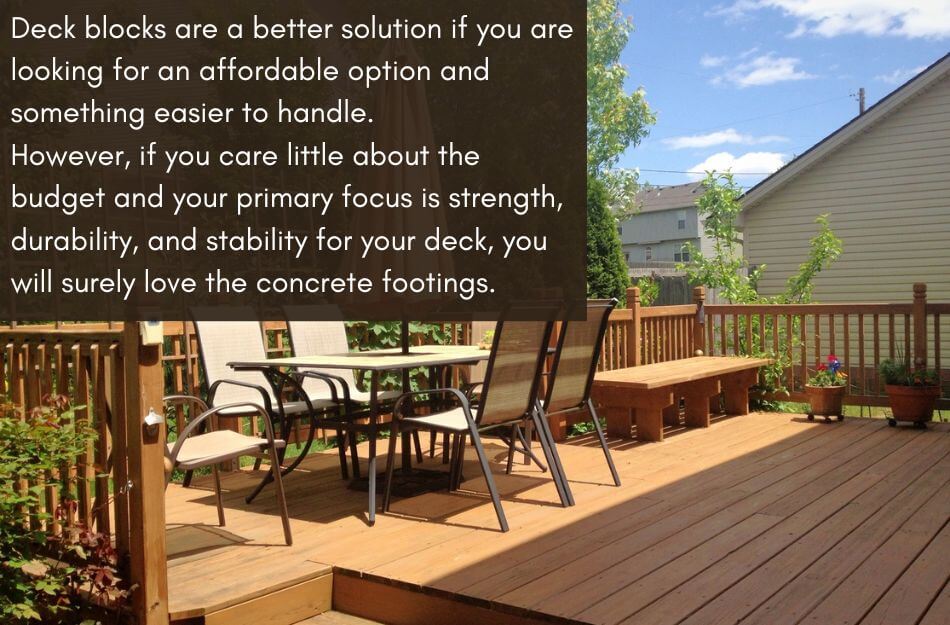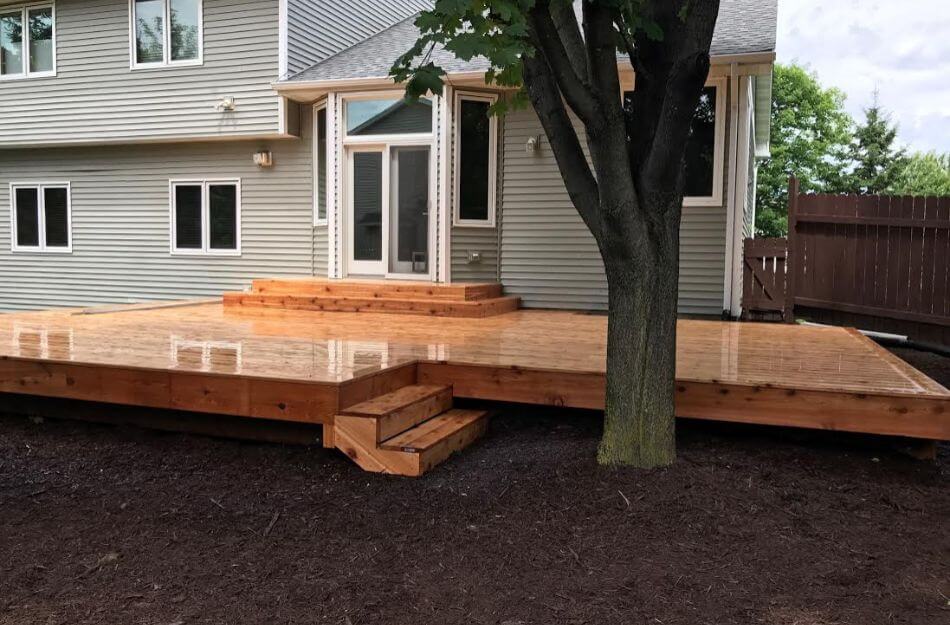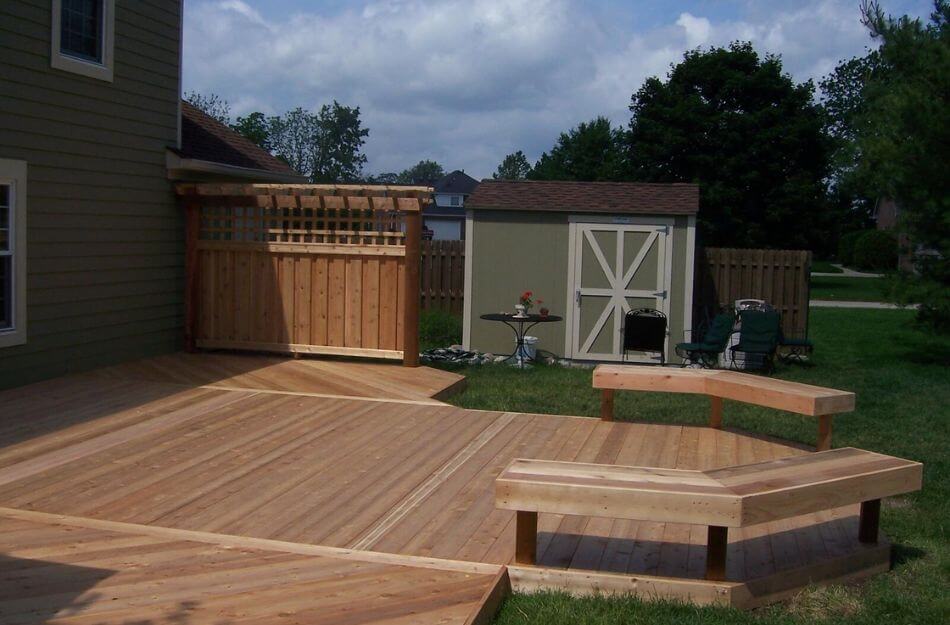The foundation of a deck is the most important factor during construction, as the entire structure has to rely on it. With many options, one might need clarification about which foundation is best for your deck.
The most popular options stand to be deck blocks and concrete footings, but both of these have their pros and cons.
Deck blocks are a better solution if you are looking for an affordable option and something easier to handle.
However, if you care little about the budget and your primary focus is strength, durability, and stability for your deck, you will surely love the concrete footings.

Table of Contents
- 1 What Are Deck Blocks?
- 2 What Are Concrete Footings?
- 3 What Factors To Consider Before Deciding
- 4 Pros And Cons Of Concrete Footings
- 5 Pros and Cons of deck blocks
- 6 Cost Differences
- 7 When Should You Use Concrete Footings vs Deck Blocks?
- 8 Can Deck Block Supports Be Used in Place of Concrete Footings?
- 9 Final thoughts
What Are Deck Blocks?
Deck blocks are concrete blocks that are meant to hold the structure underneath.
They are easy to use and extremely functional, allowing you to build a reliable base that can provide stability and strength to the platform above.
We usually see two types of deck blocks:
- The first type has an indentation on the top. This is specifically for a 4×4 post to be fixed in place.
- The second type has a cross-shaped indentation to support the beam directly. This eliminates the need for intervening posts.
The average height of these blocks is around seven inches, meaning they have enough tensile strength to hold your deck.
The number of blocks required depends on the size and design of the deck you want to build. When you place the deck blocks, keep the spacing between them similar to deck posts.
The deck height should be at most five feet from the deck blocks.
A common problem deck builders face is that the indentation on the blocks is bigger than the beams themselves; hence the format is only stable once two beams are tied and fixed together.
Hence, it makes the process a two-person job, so ensure you have someone to help you if you are starting this project alone.
If you’re wondering how the deck will stay in its place and how the wind will not affect it, the answer is quite simple; the weight of the deck. The forces acting downwards are greater than those acting sideways on the deck.
- When you place the deck blocks, keep the spacing between them similar to deck posts.
- The deck height should be at most five feet from the deck blocks.
- A common problem deck builders face is that the indentation on the blocks is bigger than the beams themselves.
- You would need two people for this job, as once two beams have been fixed, the platform becomes stable.
- The deck’s weight will provide ample stability, so you no longer have to worry about strong winds. The forces acting downwards are greater than those acting sideways on the deck.
However, you need to ensure that the place you’ve chosen for your deck is not prone to soil erosion as if it is the case, it might affect the sturdiness of your platform’s base.
Also Read: Deck Vs Porch: Which One Is Best?
What Are Concrete Footings?
Concrete footings are made of rebar reinforcements that have been poured into an excavated trench.

They keep the structure stable and prevent it from sinking into the ground while providing a stable base.Besides, once the footing solidifies, it is super-sturdy and extremely durable.
Concrete footings go quite deep into the ground, which is the main reason for their stability and strength.
They are usually placed 12 inches (minimum) under the frost line (the point at which soil can freeze in cold weather). Moreover, if the soil were previously disturbed or dug anytime before, the depth would have to be even greater.
The reason for this is that as the posts go into the soil, the soil around them is compressed, hence, providing them with sturdy support.
They are extremely functional and bring along many other benefits. For instance, they save your wooden structure from direct contact with damp soil. Resultantly, weed plants, humidity, and termites can no longer access your deck.
The foundation provided by concrete footings is quite robust as they are hammered into the ground, and a concrete mixture is poured from the top, preventing the posts from swaying around in the wind or rain when the soil underneath becomes soft and moist.
- Dig the ground to the recommended depth and place the steel posts.
- Hammer the posts into the ground using a jackhammer to secure them.
- Once they have reached the desired depth, pour the concrete mixture and fill it up
- Please wait for it to dry and make sure that all footings are at the same height and angle.
- Once dried, you can start building your deck on top.
What Factors To Consider Before Deciding
Before you decide which one suits you the best, there are a few factors that you must consider, such as price, ease of installation, durability, etc.
Price
Affordability is the biggest concern for many people when building a deck; hence, it is important to select a foundation structure that is affordable and durable at the same time.
Deck blocks are costly as each costs approximately $4-6. The number of deck blocks you require is obviously figured out according to the deck size.
However, on average, you would need 9 deck blocks to build a deck of 10×8 feet. The cost for this comes to around $36 to $54.
On the other hand, you would need a budget of $240 to $560 for concrete footings as their general pricing is almost $3-$7 per square foot.
Ease of Installation
Deck blocks do not have a complex installation process as they are ready-made, and you have to place them in the desired spot.
The indentations on the top make it easier to install posts, and you probably would only need a few hands-on boards to get the job done.
Whereas concrete footings are difficult to install as you need to dig the ground to a certain depth, install rebar reinforcements, and pour concrete mixture into the trench.
Moreover, you will need professionals experienced in construction and labor work if you need more knowledge.
You May Also Like: Deck Block Vs. Post Holes: Which Is Better?
Durability
Although deck blocks are sturdy, they are still prone to damage over time.

Firstly, if your area has a high humidity level or you experience frequent rains, the blocks can sink into the ground slowly, which can be annoying and dangerous at the same time.
Sinking will rob you a few inches of the height of your deck, while uneven or excessive sinking can risk the stability of your deck.
Moreover, if too much weight is on the deck, the posts could dig deeper into the indentations, leading to cracks or even breaking.
A major reason can be the porous texture of deck blocks. Water and moisture can seep into the pore of concrete blocks and can reach your posts.
This nullifies the purpose of deck blocks which is to provide a sturdy base and prevent moisture from getting to the posts or the deck. Besides, concrete blocks can get a little soft if wet from the inside.
Now, this is not a significant problem, but provided the deck’s weight, the posts will surely be pressed more and more inside the blocks.
As this happens continuously, the deck blocks can get cracked and eventually break, causing the posts and the deck to fall from the height.
On the flip side, concrete footings are the sturdiest solution you can have without worrying about any of the factors above.
They are the most reliable option for your deck’s foundation as they have extraordinary loading capacity allowing you to get as much furniture or people on board on your deck as you want.
Related: How To Seal Pressure Treated Wood?
Pros And Cons Of Concrete Footings
Pros
- Concrete footings are made on the spot on your deck’s location; hence, carrying all the material to the location is easier.
- You can bid farewell to manufacturing defects or damage in transport as concrete footings are made on-site. This improves the quality standards and eliminates the risks of damage.
- All the materials are abundantly available, so you don’t have to fear any shortages at the time of construction.
- Concrete footings are the best option if you live in a colder environment, as they can withstand harsh weather situations.
- The deep underground support system allows for added stability.
- Workers are experienced in this field; hence, it would be easy to find a specialist or solve any problem.
- They can withstand much greater loads as compared to deck blocks.
Cons
- Concrete footings are very expensive, and you would also have to bear the cost of hiring professionals.
- They require much time for installation and need to be more friendly toward time-critical projects.
- It is quite hard to repair concrete footings if they are damaged, and even if you can repair them, you would require the help of professionals again.
- The maintenance cost needs to be lowered.
- Installing concrete footing is more than just a one-person job; you must hire a team to complete the project.
Don’t Miss: How To Get Green Off Pressure Treated Wood?
Pros and Cons of deck blocks

Pros
- It is fairly easy to install deck blocks, as all you have to do is place them at the marked spot.
- Deck blocks do not require any digging and can be placed anywhere on a suitable surface.
- You can experience various deck block sizes and shapes and choose the most appropriate for your deck-building purpose.
- Deck blocks are easy to handle, and the installation process isn’t very difficult; hence, a single person can also do the job.
- Deck blocks are very cheap compared to concrete footings and are a sturdy and affordable solution.
- Being made of concrete, they do not decay and provide a suitable platform to stabilize your deck.
- They withstand the harshness of weather and do not corrode or crack easily.
Cons
- Although deck blocks are inexpensive, you have the added expense of beams and posts to build your deck on.
- As they are ready-made, some may be defective or damaged during transportation.
- Only a few people opt for deck blocks; hence, they are less common than concrete posts. This means you might need more time to find solutions to rising problems.
- They require a perfectly stable surface as they are not fixed to the ground. Hence, if you want to avoid inconveniences, you should level the ground underneath first.
Cost Differences
Deck blocks and concrete footings have a wide range of prices. Typically, deck blocks are less costly than concrete footings.
It is so that deck blocks, which are pre-formed, can be used instead of conventional footings that need to be dug or poured.
deck blocks also require less labor to install, which can reduce expenses.
It’s essential to remember that a deck’s overall expenditure will impact several elements, including size, supplies, and location, making it easier to generalize about which is less expensive.
However, Concrete footings call for digging and concrete pouring, they can be more costly than deck blocks.
The price of concrete foundations will also vary depending on the location, including the expense of labor, materials, and local permits.
However, concrete footings are considered a more resilient and long-lasting choice for a deck block, which can ultimately save money on repairs and replacements.
It’s essential to consider the cost of the foundation and the cost of the decking, fences, and other characteristics that will be part of the deck when estimating the cost.
Additionally, it’s crucial to consider local construction codes because some might call for footings, which would raise the price.
When Should You Use Concrete Footings vs Deck Blocks?
In a variety of circumstances, deck supports and concrete footing are required:

- Concrete footings is required If you’re constructing a long-term construction that needs to be protected from frost. While deck blocks are used for freestanding and floating constructions.
- When frost heave rules are in effect, concrete footings must be used instead of deck blocks.
- You cannot use deck blocks in areas of strong elevation or strong winds instead concrete flooring can be used.
- Concrete flooring can only be installed on standard homes. While deck blocks can be used for small, freestanding buildings.
Can Deck Block Supports Be Used in Place of Concrete Footings?
Homeowners, architects, and contractors frequently argue whether to construct a deck’s block using concrete footings or piercings.
Deck blocks are viewed as a convenient and affordable choice for a deck foundation on the one hand. They arrive pre-formed with holes for fastening the deck’s posts and can be constructed from concrete or plastic.
However, concrete footings are considered a stronger and more long-lasting choice for a deck foundation. Concrete footings are typically poured straight into the ground.
They offer a solid base for the deck because they are usually wider and deeper than pier blocks.
Both choices have benefits and drawbacks, so it’s crucial to consider your unique requirements, financial constraints, and regional building regulations before choosing.
Final thoughts
Deck blocks and concrete posts are both very reliable options for the foundation of your deck.
If you were also confused about which one to choose from, the information above would’ve surely satisfied you and answered all your questions.
Whatever you are constructing, you must pay attention to the foundations. Deck blocks are prefabricated foundations, as opposed to on-site concrete footings.
There are more factors to consider than convenience and expense when deciding between deck blocks and concrete footings.
Deck blocks are less expensive and easier to place than concrete footings.
Still, they are only appropriate for certain types of buildings and environments, such as decks and reduced structures in climates with little risk of frost.
So, deck blocks might be a choice if you’re constructing a tiny, medium-sized, moderate, freestanding deck
Along with being far from water, you must be protected from heavy winds and uplift and not be on a waterfront or flood zone.
Additionally, they ought to be in a location without freezing temperatures and with good soil drainage not in gravel soils.
Recent Posts
Although deck sealing may not be at the top of your summer to-do list, you shouldn’t put off a task.One such deck that channels the opposite of the lively and enjoyable vibe you want from an...
Any home would benefit from having a deck because it adds more area for socializing, relaxing, and outside activities.Garden decking that has been properly polished can be elegant and lovely. It...
